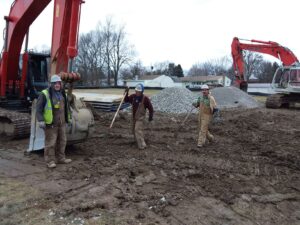 This week, Righter’s crew at the Century Acres Pump Station project – Robert Ward, Josh Priest, Shawn Ison, and Supervisor Tom Ison – discussed ladder inspections and safety during their weekly safety talk. According to the World Health Organization, the United States leads the world in ladder deaths. Each year, there are more than 164,000 emergency room-treated injuries and 300 deaths caused by falls from ladders. Most ladder deaths are from falls of 10 feet or less. Falls from ladders are the leading cause of death on construction sites. Over the past decade, the number of people who have died from falls from ladders has tripled.
This week, Righter’s crew at the Century Acres Pump Station project – Robert Ward, Josh Priest, Shawn Ison, and Supervisor Tom Ison – discussed ladder inspections and safety during their weekly safety talk. According to the World Health Organization, the United States leads the world in ladder deaths. Each year, there are more than 164,000 emergency room-treated injuries and 300 deaths caused by falls from ladders. Most ladder deaths are from falls of 10 feet or less. Falls from ladders are the leading cause of death on construction sites. Over the past decade, the number of people who have died from falls from ladders has tripled.
The OSHA standards for ladders are as follows:
OSHA 1910.25(d)(1)(x)
– Ladders shall be inspected frequently and those which have developed defects shall be withdrawn from service for repair or destruction and tagged or marked as “Dangerous, Do Not Use.”
OSHA 1910.26(c)(2)(vi)
– Ladders are to be inspected:
(c)(2)(vi)(a) If ladders tip over or
(c)(2)(vi)(d) If ladders are exposed to oil and grease
OSHA 1910.27(f) – Fixed Ladders
All ladders shall be maintained in a safe condition. All ladders shall be inspected regularly, with the intervals between inspections being determined by use and exposure.
These required frequent inspections must be documented. Perhaps the easiest way is to have stickers or tags directly on the ladder itself and to have a ladder log to ensure they are all inspected as required. Unfortunately frequently is a very subjective word. Truly each ladder must be evaluated on its use and exposure to damaging influences. You will want to inspect a ladder utilized daily that is in a high exposure area much more often than the office step stool used every now and then.
Although ladders are part of our everyday life at both work and home, it’s important we don’t take them for granted. Ensure you inspect and utilize ladders appropriately.
